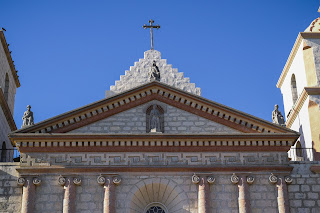2012 California Road Trip
Part 111
Santa Barbara Mission and Dunes Oceano
After 3 days in Los Angeles visiting family and friends for the Thanksgiving holiday, we headed north toward Morro Bay and the Central California coast below Big Sur. Our first stop was at the mission at Santa Barbara.
The Mission grounds occupy a rise between the Pacific Ocean and the Santa Ynez Mountains, and were consecrated by Father Fermín Lasuén, who had taken over the presidency of the California mission chain upon the death of Father Presidente Junípero Serra. Mission Santa Barbara is the only mission to remain under the leadership of the Franciscan Friars since its founding, and today is a parish church of the Archdiocese of Los Angeles.
Here is a detailed shot of the fountain and a humming bird pausing for a drink.
Here is a shot of the fountain and the front of the mission.
Here is a photo of some fading sidewalk art.
Here is a close up of a cactus plant.
This shot shows one of the arch ways between section of the mission.
This shot shows a few of the plants and trees on the mission grounds framed in an arch.
Dune Oceano and Beaches North
These are massive sanddunes located near Pismo Beach. These dunes are very large and lead right to the ocean. Ed Weston and Ansel Adams made several famous photographs on these dunes. The route we took to get to the dunes was amazing in that we drove through a forested area and then up a paved road, mostly covered by sand, for about 2 miles and then cresting a hill and came to a parking lot over looking the dunes and the ocean.
We talked to a couple that had spent 2.5 hours hiking to the top of the highest dune starting at our parking area.
The beaches and ocean surf, and distant mountain vistas were really great from this beach.
















































